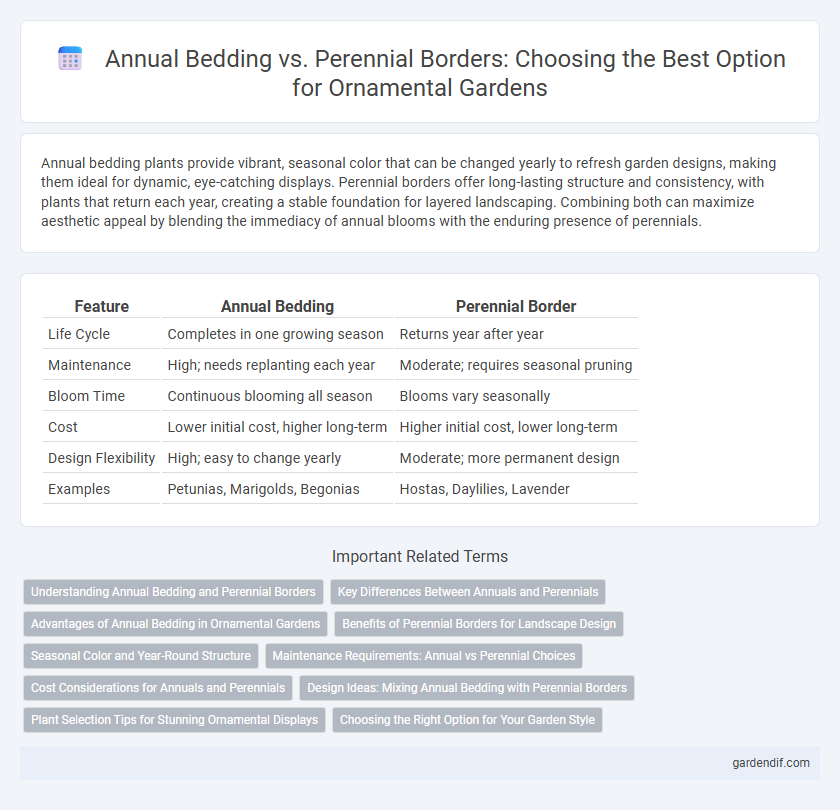
Annual Bedding vs Perennial Border Illustration
Annual bedding plants provide vibrant, seasonal color that can be changed yearly to refresh garden designs, making them ideal for dynamic, eye-catching displays. Perennial borders offer long-lasting structure and consistency, with plants that return each year, creating a stable foundation for layered landscaping. Combining both can maximize aesthetic appeal by blending the immediacy of annual blooms with the enduring presence of perennials.
Table of Comparison
| Feature | Annual Bedding | Perennial Border |
|---|---|---|
| Life Cycle | Completes in one growing season | Returns year after year |
| Maintenance | High; needs replanting each year | Moderate; requires seasonal pruning |
| Bloom Time | Continuous blooming all season | Blooms vary seasonally |
| Cost | Lower initial cost, higher long-term | Higher initial cost, lower long-term |
| Design Flexibility | High; easy to change yearly | Moderate; more permanent design |
| Examples | Petunias, Marigolds, Begonias | Hostas, Daylilies, Lavender |
Understanding Annual Bedding and Perennial Borders
Annual bedding plants provide vibrant color and seasonal interest by completing their life cycle within one year, making them ideal for creating dynamic, changing displays. Perennial borders consist of plants that live for multiple years, offering structure and long-term stability with blooming cycles that recur annually. Understanding the growth habits and maintenance requirements of these plant types is essential for designing effective ornamental garden landscapes.
Key Differences Between Annuals and Perennials
Annual bedding plants complete their life cycle within one growing season, offering vibrant blooms and quick garden transformation but requiring replanting each year. Perennial borders consist of plants that live for multiple years, developing deeper root systems and often providing structure and stability in garden design. The key differences lie in lifecycle duration, maintenance requirements, and seasonal performance, influencing garden planning and visual impact.
Advantages of Annual Bedding in Ornamental Gardens
Annual bedding plants offer vibrant, season-long color and quick growth, making them ideal for rapidly transforming ornamental gardens. They provide flexibility in design with the ability to change plant varieties each year to suit evolving aesthetic preferences and seasonal themes. Their higher bloom density enhances visual impact, attracting pollinators and boosting garden biodiversity.
Benefits of Perennial Borders for Landscape Design
Perennial borders offer long-lasting beauty and reduced maintenance compared to annual bedding, making them ideal for sustainable landscape design. Their deep root systems improve soil health and increase drought resistance, ensuring a resilient and vibrant garden year after year. Diverse perennial selections provide seasonal interest with varied textures, colors, and bloom times, enhancing visual appeal and ecological value in outdoor spaces.
Seasonal Color and Year-Round Structure
Annual bedding plants deliver vibrant seasonal color with a diverse palette that changes each year, ideal for dynamic garden displays. Perennial borders provide year-round structure and stability, featuring plants that return each season and offer consistent foliage and form. Combining both approaches maximizes garden appeal by blending transient, bold hues with enduring architectural elements.
Maintenance Requirements: Annual vs Perennial Choices
Annual bedding plants demand frequent maintenance, including regular watering, deadheading, and replanting each season to maintain vibrant displays. Perennial borders require less ongoing care, with initial establishment involving mulching and occasional pruning to sustain plant health and aesthetics. Choosing between annuals and perennials depends on the gardener's preference for season-long color versus long-term structure with reduced maintenance efforts.
Cost Considerations for Annuals and Perennials
Annual bedding plants typically incur higher recurring costs due to seasonal replanting and ongoing purchase of seeds or seedlings, while perennials generally require a larger initial investment but lower maintenance expenses over time. Perennials provide long-term savings by returning each year without the need for replanting, reducing labor and material costs compared to annual beds. Gardeners must weigh upfront costs against longevity, factoring in the frequency of replacement and maintenance requirements inherent in annual versus perennial planting schemes.
Design Ideas: Mixing Annual Bedding with Perennial Borders
Combining annual bedding with perennial borders enhances garden design by introducing dynamic color changes alongside structural longevity. Annuals such as petunias and marigolds provide vibrant seasonal blooms, while perennials like coneflowers and hostas maintain consistent foliage and texture throughout the year. This integration allows for continuous visual interest, encourages biodiversity, and offers flexibility in garden layout adjustments seasonally.
Plant Selection Tips for Stunning Ornamental Displays
Choose annual bedding plants like petunias, marigolds, and impatiens for vibrant, season-long color, while integrating perennials such as echinacea, coneflowers, and hostas to provide structure and long-term interest in borders. Prioritize plants suited to your climate zone and consider bloom time stagger to maintain continuous visual appeal throughout the growing season. Incorporate a mix of foliage textures and flower shapes to enhance depth and create stunning ornamental displays with dynamic contrasts.
Choosing the Right Option for Your Garden Style
Annual bedding plants provide vibrant, season-long color and the flexibility to change garden designs yearly, ideal for gardeners seeking dynamic visual interest. Perennial borders offer long-term structure and low-maintenance beauty with plants that return every year, suited for classic, stable garden styles. Selecting between annual bedding and perennial borders depends on garden size, desired maintenance level, and preference for either evolving or enduring floral displays.
Annual Bedding vs Perennial Border Infographic

 gardendif.com
gardendif.com